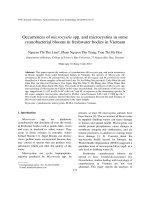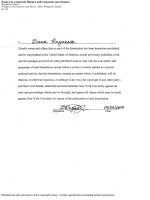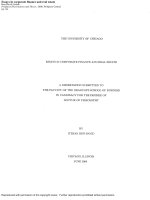Colour and meaning in corporate logos
Bạn đang xem bản rút gọn của tài liệu. Xem và tải ngay bản đầy đủ của tài liệu tại đây (134.24 KB, 12 trang )
www.palgrave-journals.com/bm
© 2009 Palgrave Macmillan 1350-23IX Brand Management Vol. 16, 8, 545–555
Niki Hynes
Department of Marketing,
University of Strathclyde,
Glasgow G4 0RQ,
UK
Tel: + 1 0141 548 3193
E-mail:
Colour is sometimes referred to as the
‘ silent salesperson ’ as it exerts persuasive
power at a subliminal level.
3
This idea can
be easily illustrated: an image shown in
vivid reds and oranges gives a completely
different feel and meaning from the same
image shown in pale blues and greens. This
study therefore addresses the need to
examine how people perceive the colour,
design and meaning of logos to examine
how these interlink to and affect the iden-
tity of the organisation,
4 – 6
a topic which
to date has received little attention.
7
This
study uses a two-stage experimental design
to capture if consumers are able to match
logo shapes to particular meanings (words)
and secondly to determine whether
respondents when presented with a logo
and mission statement can identify a
colour which best conveys this meaning.
BACKGROUND
The logo acts as a badge of identifi cation,
8
as a mark of quality
9
and as a way to
INTRODUCTION
The corporate identity of a fi rm is strate-
gically important in differentiating com-
panies and helps to establish customer
loyalty. Of the elements which help to
establish this, corporate visual identity
(CVI) includes all visual aspects of the fi rm
including buildings, products, uniforms of
staff, paperwork and the corporate logo.
1,2
The corporate logo has various elements
of design which are important including
the shape, image, style and size, as well as
the colour(s) used. Logos add value by
stakeholders seeing and remembering the
logo (recognition) but to be effective,
the logo must serve as a signature of
the company, by clearly linking the
shape, design or colour to the organisation
it represents. The most easily recalled
logos usually have a unique shape (Nike,
Apple, Chanel, Microsoft, etc). Some go
further to associate strongly with a par-
ticular colour as well — Coca Cola (red),
Chanel (black), McDonalds (golden yellow
on red).
Colour and meaning in corporate
logos: An empirical study
Received (in revised form): 15th February, 2008
NIKI HYNES
is Lecturer in Marketing at the University of Strathclyde in Glasgow. She has received degrees from the University of
London, The University of Edinburgh and Lincoln University in New Zealand. Her present research interests include
marketing in high technology fi rms, market and technological orientation, strategic alliances and corporate identity,
and she has published in International Journal of Technology Marketing and International Journal of Technology Management.
Abstract
Corporate visual identity helps establish and maintain a company ’ s corporate image, of which the
colour and design of a company ’ s logo is central. This study examines the triadic relationship
between colour, design and the evoked meanings of logos to understand how these contribute to
building a consistent corporate image. Results strongly indicate that consumers make clear
judgements about the image of a fi rm from the logo design and have strong opinions about which
colours are appropriate for different corporate images.
Journal of Brand Management (2009) 16, 545 – 555. doi: 10.1057/bm.2008.5;
published online 18 July 2008
Keywords
corporate visual identity ;
logos ; colour ; design
Keywords
corporate visual identity ;
logos ; colour ; design
HYNES
© 2009 Palgrave Macmillan 1350-23IX Brand Management Vol. 16, 8, 545–555
546
increase a company ’ s reputation.
9,10
In
addition, if managed correctly, it may
serve to create competitive advantage
1
and simplify the task of formal corporate
communications.
9
The company ’ s name,
logo, typeface and colour scheme are
typically considered to be the main
components of CVI.
4,11,12
Van Riel and Van den Ban
1
distinguish
between the intrinsic properties of logos
(that is the degree of ‘ representativeness ’
of the logo) and extrinsic properties.
Extrinsic properties are those originating
from associations with the company. This
is easily illustrated in the example of Nike
which in design terms has strong referen-
tial elements — the swoosh representing
movement; this has a low representative-
ness but high extrinsic values making the
distinctive logo. The power of extrinsic
properties is high; the degree of realism in
the design is inversely related to the ability
to attribute additional meanings
4
but little
research has examined whether illustrative
or abstract designs are more appropriate
to particular organisations.
Logo colour is also very important due
to its mnemonic quality in the areas of
recognition and recall.
4,13
Colour may
play a role in imparting information,
creating lasting identity and suggesting
imagery and symbolic value.
4,13
Dowling
8
notes that colour is often an afterthought,
left to the designer ’ s or corporate man-
ager ’ s whim and is often decided upon
without any consideration of its psycho-
logical and strategic uses. Although the
importance of colour in CVI has received
little or no academic attention, there is
substantial research outside the marketing
fi eld which shows the importance of
colour in recognition and recall and more
importantly, the idea that colour being
used to elicit different emotional responses.
9
Three main schools of complementary
thought exist on the meaning of colours:
chromodynamics, the ‘ temperature ’ of
colour and direct cultural effects. It is
thought that colours may carry emotional
and neurophysiological values and may
affect levels of excitation and cognitive
stimulation.
4
The Pantone Company
14
( www.pantone.com ) and others
7,15
report
that colours have a direct, physiological
effect, for example, red can raise blood
pressure and appetite, an effect known as
‘ chromodynamics ’ . This effect is closely
linked to the ‘ temperature classifi cation ’ of
colours, stemming from nature.
15 – 17
Birren
18
suggests that the excitation level
of colour is directly linked to the ‘ tem-
perature ’ of the colour, where the warm
colours including red, yellow and orange
may mentally stimulate and can create
excitement or even anger.
4
The cool col-
ours are thought to have a calming effect
due to their relatively low excitation level
and are often associated with restfulness,
nurturing and peace. This idea of a tem-
perature of colour is used commonly in
the popular press and in interior design;
however, the theory of chromodynamics
has been heavily criticised because it is
diffi cult to distinguish between cultural
and natural associations of colours. For
example, red may raise blood pressure
because it is the colour of blood, and it
may also serve as an appetite-stimulant as
it is a common colour in existing foods.
17
Culture can also affect the meaning of
colour. Examples of this effect are, for
example street / road signs which need to
convey messages clearly in less time than
it would take to read and digest a descrip-
tion of its meaning.
17
In this context,
some, but not all colours have precise and
direct connotations (eg red means stop and
green means go), which may serve as evi-
dence to support Dowling ’ s
8
earlier claim
of faster recognition through colour than
shape or form. Instant recognition through
colour can potentially be very useful in
© 2009 Palgrave Macmillan 1350-23IX Brand Management Vol. 16, 8, 545–555
547
COLOUR AND MEANING IN CORPORATE LOGOS
commercial applications such as product
packaging, where consumers speeding down
supermarket aisles rely on colour to distin-
guish between brands.
3
In addition, despite
some limited and well-known cultural
differences in colour (red for good luck in
China, etc), there are more commonalities
in colour meaning across cultures than
differences supporting chromodynamics
theory, or through nature. Some fi rms use
the power of colour in their design, for
example, the appetite-stimulating red of
McDonalds or the environmentally friendly
green of BP. As Fraser and Banks
17
(p. 12)
state, ‘ it is no coincidence that the strongest
use of colour is often found where someone
is trying to sell you something ’ . In summary,
logos are one of the most powerful elements
in establishing a CVI. Colour and design are
two of the major aspects of the logo ’ s char-
acteristics and the importance of selecting
both an appropriate design and an appro-
priate colour both for the design and for
the company image is therefore very high,
yet one which has received little academic
attention.
METHODOLOGY
In order to overcome some of the diffi cul-
ties in separating the associations between
corporate identity, logo design and colour,
an experimental and exploratory method-
ology was used. It is impossible to show a
logo without using colour since black and
white have associated meanings. Therefore,
this experimental study took a two-stage
approach where respondents were asked
fi rstly to select three words from a given
list which best described the company
depicted by a black and white logo fi cti-
tious and unknown logo. They were then
given a description of a fi ctitious company
for each logo (which incorporated three
of the words used on the list already asso-
ciated with the logo), shown the logo in
eight different colours and asked to select
which colour best suits the logo. The ten
words used to describe each logo were
derived from the research on colour theory
and associated with the eight colours. This
experimental study therefore tested two
elements of the meaning — design — colour
triadic relationship of logos.
Respondents were selected in two
waves of data collection. The fi rst was a
random street intercept in Scotland. In the
second wave of data collection, an online
survey was run with a selection of online
MBA students. In each case, respondents
were pre-qualifi ed by checking for colour
blindness, age (between 18 and 60) and
for cultural background — all had lived or
worked in the UK for a number of years.
The use of an online survey brings advan-
tages in terms of randomising the repre-
sentation of words and colours, but also
has associated problems with portrayal of
the colour images. The colours were delib-
erately scrambled to avoid the deduction
of any meaningful order (such as from
warm to cold) and to ensure equal chance
of each colour to be chosen. Eight dif-
ferent colours were selected for use in this
study including blue, red, yellow, green,
purple, and orange, pink and brown.
RESULTS
The results are described below; each of
the eight logos is presented followed
by the words chosen by respondents to
represent the meaning of the logo. The
mission statement given to respondents to
create a company image is then presented,
followed by a summary of preferred colour
choice for this combination of words
and logo design. The fi nal column shows
signifi cant correlations between colours
and words, and the direction of this
correlation. Words supported by colour
theory are shown in italics.
HYNES
© 2009 Palgrave Macmillan 1350-23IX Brand Management Vol. 16, 8, 545–555
548
House
Total % Colour
correlation
Homely 272 82.2 Brown ( − )
Dependable 133 40.2 Blue ( − ), Green ( + ) ,
Orange (+)
Warm 144 43.5 Red ( + ), Blue ( − )
Trustworthy 112 33.8
Reliable 89 26.9 Green ( + )
Thoughtful 46 13.9 Red (+)
Imaginative 43 13.0 Red (+)
Healthy 34 10.3
Dynamic 25 7.6
Refreshing 19 5.7 Yellow (+)
The representative nature of this logo is
echoed in the selected words: ‘ homely ’ , ‘ warm ’
and ‘ dependable ’ . ‘ Trustworthy ’ and ‘ reliable ’
also scored highly. These are all words asso-
ciated with earthy colours such as brown or
blue. The meaning of this representative logo
is therefore a useful metaphor for a company ’ s
identity where it seeks to establish itself as a
dependable warm builder. It would not suit
more innovative or commercial builders.
Mission : ‘ This company is a long estab-
lished house-builder who wants to be
seen as dependable, trustworthy and reli-
able. Which colour best suits the logo for
this organisation? ’
Total
Brown 138
Blue 82
Green 63
Orange 21
Red 16
Pink 0
Purple 8
Yellow 2
Total 330
The company ’ s description used words
associated with blue and / or brown, and
the overwhelming majority (65 per cent)
of respondents chose either brown or blue.
The choice of colour may have been com-
plicated by the fact that most houses have
some degree of brown colour on them.
House is a representative logo for which
respondents had clear ideas about the
meaning of the design, which matched
well to the colour choice. The match
between mission statement and colour
choice is also broadly present (blue being
the ‘ correct answer ’ and the second most
commonly chosen colour) but with brown
as a logical choice for both desired
meaning and inferred meaning. For this
representative design, yellow (refreshing),
green (reliable) and red (warm) were
signifi cantly related to meanings predicted
by colour theory, but not selected as the
best colour for this company ’ s logo.
Globe
Total % Colour
correlations
Protective 196 59.2
Stability 192 58.0 Pink ( − )
Reliable 127 38.4 Red (+), Purple (+)
Imaginative 108 32.6 Yellow ( + )
Renewal 109 32.9 Orange (+)
Thoughtful 89 26.9
Playful 46 13.9 Yellow ( + )
Healthy 23 6.9
Passionate 20 6.0
Homely 10 3.0
This representative logo apparently had
two groups of meanings: ‘ protective ’ and
‘ stability ’ being chosen by over half of all
respondents. The second grouping included
‘ reliable ’ , ‘ imaginative ’ and ‘ renewal ’ . This
was an implicitly representative logo
showing a globe with stars, which are
arguably stylised from a fl ag — but without
any particular inherent meaning.
Mission : ‘ This is a logo of a governmental
aid organisation that aims to provide shelter
© 2009 Palgrave Macmillan 1350-23IX Brand Management Vol. 16, 8, 545–555
549
COLOUR AND MEANING IN CORPORATE LOGOS
and temporary housing to disaster relief
victims. They want to be seen as being
protective, homely and stable. Which
colour best suits the logo for this organisa-
tion? ’
Total
Blue 168
Green 63
Brown 31
Red 25
Orange 18
Purple 14
Yellow 8
Pink 3
Total 330
The description of the company used
words normally associated with brown while
respondents overwhelmingly selected blue
(more than 50 per cent). The words chosen
for the design of this logo were also over-
whelmingly blue-associated: ‘ protective ’ and
‘ stable ’ suggesting a strong link between
meaning, design and colour but inconsistent
with the given mission statement.
Stylised heart / double clef
Words
Total % Colour
correlation
Passionate 237 71.8
Playful 166 50.3 Purple (+)
Exciting 136 41.2 Orange ( − ), Purple
( + ) , Brown ( − )
Imaginative 90 27.3
Regal 75 22.7
Dynamic 69 20.9 Purple (+)
Energetic 65 19.7 Blue (+), Brown ( − )
Refreshing 39 11.8 Pink (+)
Protective 32 9.7
Reliable 19 5.8
Respondents overwhelmingly chose
the word ‘ passionate ’ to describe this
implicitly representative logo followed
by ‘ playful ’ and ‘ exciting ’ . ‘ Passion ’ and
‘ excitement ’ are usually associated with
red, although ‘ playful ’ is more commonly
associated with yellow or orange.
Mission : ‘ This is the logo for an orchestra.
It is passionate about performing at the
highest quality, and to be seen as a
dynamic, exciting provider of classical
music. Which colour best suits the logo
for this orchestra? ’
Total
Purple 94
Red 73
Blue 54
Brown 46
Orange 29
Green 16
Pink 9
Yellow 9
Total 330
Purple was the most commonly chosen
colour, followed by red. Red closely
matched the selected words although
the world ‘ regal ’ is the one most com-
monly associated with purple and this was
chosen by one-third of all respondents.
Purple is rarely seen in nature and for
many centuries purple dye was restricted
in its use — in Elizabethan times it could
only be legally worn by Royalty, and
as far back as Roman times only the
most powerful emperors wore purple.
Perhaps because of this it is seen as luxu-
rious and it is now commonly used in
Cadbury chocolate advertisements which
may have changed its associations
explaining the correlations between purple
and ‘ dynamic ’ , ‘ exciting ’ and ‘ playful ’
which are not supported by traditional
colour theory.
HYNES
© 2009 Palgrave Macmillan 1350-23IX Brand Management Vol. 16, 8, 545–555
550
Bunny
Total % Colour correlation
(only sig. values
reported)
Fun 245 74.2
Imaginative 143 43.3
Energetic 109 33.0 Pink ( − )
Refreshing 112 33.9 Green ( + )
Homely 91 27.6 Purple (+), Green (+)
Cheap 75 22.7
Dynamic 69 20.9
Sensual 59 17.9
Reliable 30 9.1 Green ( + )
Healthy 30 9.1 Purple (+)
This logo has few intrinsic qualities
although is likely to be associated with
children or clothing due to the words
included. Over 74 per cent of all respond-
ents chose the word ‘ fun ’ , followed by a
range of other words including ‘ imagina-
tive ’ , ‘ energetic ’ , ‘ refreshing ’ . Fun is usually
associated with orange and yellows, as is
imaginative and energetic.
Mission : ‘ This company sells children ’ s
cotton clothes. It wants to be seen as fun and
to be worn by energetic, healthy people. Which
colour best suits the logo for this company? ’
Total
Pink 117
Yellow 86
Orange 49
Red 46
Brown 16
Green 10
Purple 5
Blue 1
Total 330
The bunny logo was designed to com-
municate pink, associated with health and
energy giving. These characteristics are also
associated with yellow and clearly most
respondents chose pink for this logo, with
yellow as second choice. Surprising pink
and ‘ energetic ’ correlate negatively — the
opposite relationship predicted by theory.
Green is associated with the predicted
meanings when used in this logo, while
no other colours match their expected
meaning in this logo.
Kite
Words
Total % Colour
correlation
Happy 254 77.0 Yellow ( + ) , Purple ( − )
Cheerful 219 66.4 Red ( − ), Yellow ( + )
Energetic 124 37.6 Green ( − ), Yellow (+)
Healthy 98 29.7 Blue ( − ), Yellow (+)
Exciting 70 21.2
Refreshing 67 20.3 Green ( − ), Yellow (+)
Homely 45 13.6
Imaginative 45 13.6
Dependable 23 7.0 Blue ( − )
Stability 13 3.9
Respondents overwhelmingly chose two
words to describe the meaning of this logo:
‘ happy ’ and ‘ cheerful ’ , with ‘ energetic ’ as a
third choice. These colours would normally
be associated with yellow or orange. Yellow
was positively correlated with ‘ happy ’ and
‘ cheerful ’ , consistent with colour theory.
Mission : ‘ This is the logo of a preschool
nursery which wants to be seen as ener-
getic, cheerful and friendly place to leave
your children. Which colour best suits the
logo for this preschool? ’
Total
Yellow 76
Green 50
Purple 47
Pink 46
Red 37
Orange 36
Blue 34
Brown 4
Total 330
© 2009 Palgrave Macmillan 1350-23IX Brand Management Vol. 16, 8, 545–555
551
COLOUR AND MEANING IN CORPORATE LOGOS
The colour distribution for this
logo was much wider than the other
logos although the most commonly
chosen colour was yellow, consistent
with both the desired meaning in the
mission statement and the inferred
colour from the respondents. Given that
the kite is nonrepresentative of the
company, it is surprising that the colour /
meaning / design links were very clearly
linked.
Headphones
Total % Colour
correlation
Fun 225 68.2
Playful 178 53.9 Red (+)
Happy 123 37.3 Green (+),
Pink ( − )
Imaginative 112 33.9
Cheap 100 30.3 Red (+)
Exciting 74 22.4
Refreshing 44 13.3
Reliable 35 10.6 Yellow (+)
Stability 29 8.8
Sensual 15 4.5 Red ( − ),
Orange (+)
Respondents overwhelmingly chose
the word ‘ fun ’ to describe this logo with
‘ playful ’ and ‘ happy ’ also highly ranked.
These words are consistent with the colours
orange or yellow. The colour-meaning
correlations for this logo are all ‘ incorrect ’
yet the meanings and colour choices
are fairly consistent, suggesting that respon-
dents did not make the predicted connec-
tion between the colours in this implicit
illustrative logo.
Mission : ‘ This is the logo of a local radio
station which wants to be seen as fun,
playful and bringing happiness to its
listeners. Which logo best suits the logo
for this radio station? ’
Total
Red 88
Orange 56
Purple 48
Blue 38
Green 37
Yellow 35
Pink 23
Brown 2
Total 327
The ‘ radio ’ label was described with
words normally associated with orange, yet
the respondents were less able to select the
correct colour from the description and
most opted for red, with orange as the
second highest ranked colour.
Feet
Total % Colour
correlation
(only sig.
values
reported)
Stability 191 57.7
Contemplative 143 43.2
Visionary 122 36.9 Red ( − ) ,
Green (+)
Trustworthy 120 36.3 Pink ( − )
Truthful 100 30.2 Brown ( + )
Imaginative 66 19.9 Yellow ( − )
Energetic 62 18.7 Green (+)
Renewal 53 16.0 Purple (+),
Green (+)
Happy 27 8.2 Brown (+)
Cheerful 21 6.3
More than half the respondents chose
the word ‘ stability ’ to describe this logo,
with the words ‘ contemplative ’ , ‘ visionary ’
and ‘ trustworthy ’ and ‘ truthful ’ in a second
tier. It would seem that the words on the
logo have inspired these choices since a
pair of footprints is unlikely to evoke such
thoughts. ‘ Stability ’ and ‘ trustworthiness ’
are traditionally associated with blue or
brown while ‘ vision ’ and ‘ contemplative ’
are usually associated with purple.
HYNES
© 2009 Palgrave Macmillan 1350-23IX Brand Management Vol. 16, 8, 545–555
552
Mission : ‘ This is the logo of a religious
organisation which aims to promote strong
visionary values of truth, justice and
human rights. Which colour best suits the
logo for this charity? ’
Total
Brown 134
Blue 51
Green 46
Orange 27
Purple 22
Yellow 22
Red 18
Pink 6
Total 330
The feet logo contains the words ‘ justice ’
and ‘ charity ’ although the font was small.
Nearly half of all respondents chose
brown with blue being the second choice.
The word religious was inserted into
the mission statement to attempt to get
respondents to choose purple which would
have been consistent with the values of
visionary and contemplation. In this logo
there appears to be a confl ict between
the brown / blue connotations of stability
and trust and the connection with con-
templative and visionary. This logo seems
to have a design consistent with its
meaning but inconsistent with the pre-
ferred logo colour associated through
colour theory.
Abstract
Total % Colour
correlation
Prestigious 167 50.5 Green ( − )
Security 164 49.5
Dynamic 155 46.8 Blue (+), Yellow
( − ), Brown ( − )
Prosperity 131 39.6 Orange ( − )
Protective 116 35.0 Blue ( + ) ,
Trustworthy 87 26.3 Purple (+)
Regal 72 21.8
Fun 44 13.3 Red ( − ), Blue (+),
Purple (+)
Friendly 24 7.3
Warm 13 3.9
Half the respondents chose the words
‘ prestigious ’ and ‘ security ’ for this abstract
corporate looking logo with ‘ dynamic ’ ,
‘ prosperity ’ and ‘ protective ’ also chosen. This
suggests a strong meaning conveyed by the
simple abstract design consistent with a
company wanting to evoke values desirable
by a fi nancial institution.
Mission : ‘ This is the logo of a bank which
wants to be seen as prestigious. They aim to
provide a place where your money will
be secure and your investments grow to
make you prosperous. Which colour best
suits the logo for this bank? ’
Total
Blue 159
Red 54
Brown 35
Green 31
Yellow 18
Orange 16
Purple 14
Pink 2
Total
The wavy lines of the bank ’ s logo were
described using colours normally associ-
ated with green which has also tradition-
ally been associated with money; however,
nearly three quarters of all respondents
selected the colour blue as being the most
appropriate. This is consistent with blue
being a ‘ corporate ’ colour. This abstract
logo was clearly identifi ed as a corporate,
possibly fi nancial-type logo and strongly
associated with corporate blue.
© 2009 Palgrave Macmillan 1350-23IX Brand Management Vol. 16, 8, 545–555
553
COLOUR AND MEANING IN CORPORATE LOGOS
SUMMARY OF RESULTS
Logo Associated
words
Colour chosen
by respondent
(brackets
theory-driven
colour)
Words given
in mission
statement
Colour
associated
with mission
statement
Colour
meaning
associations
correctly
made
Homely
Dependable
Warm
Blue/Brown (blue) Dependable
Trustworthy
Reliable
Blue Green, Red
Yellow, Pink
Protective
Stability
Reliable
Blue/Brown (blue or
brown)
Protective
Homely
Stable
Brown/Blue
Green
Fun
Imaginative
Energetic
Yellow (yellow or
pink)
Fun
Energetic
Healthy
Pink/yellow
Happy
Cheerful
Yellow (yellow) Energetic
Cheerful
Friendly
Yellow Yellow
Passionate
Playful
Exciting
Purple (red) Passionate
Dynamic
Exciting
Red Purple,
Brown
Fun
Playful
Happy
Red (orange) Fun
Playful
Happiness
Orange None
Stability
Contemplative
Green/Purple
(green/purple)
Visionary
Truth
Justice
Purple Pink, Red
Prestigious
Security
Dynamic
Blue
(Green/Red)
Prestigious
Secure
Grow
Green Yellow,
Orange,
Brown, Blue
In summary, there was a very close match
in terms of the words associated with the
logo by the respondents and the ‘ mission
statements ’ of the organisation suggesting a
close match in design and meaning. In
overall terms there was a clear choice of the
cool or hot colour consistent with the
colour theory although individual colours
were often confused: red was chosen in place
of orange, or blue in place of brown. The
abstract logo and the feet logo did not show
a close colour match to either the meaning
given or the words chosen by the respond-
ents. This suggests that abstract logos have
strong associations with meaning, but that
these meanings are not necessarily refl ected
in the associated colour choices that con-
sumers see as appropriate. Implicitly illustra-
tive logos (those logos which show a known
image but out of context such as the kite /
bunny / globe and feet) show a much closer
link between colour and meaning, and the
more representative the logo selected — the
closer the links between the expected
HYNES
© 2009 Palgrave Macmillan 1350-23IX Brand Management Vol. 16, 8, 545–555
554
meaning of colour and the colour chosen
being seen as inferring those qualities on
the fi rm through its logo.
DISCUSSION AND CONCLUSIONS
The corporate identity of a fi rm should
refl ect its values, mission statement, strategy
and characteristics,
6
and the logo design
and colour can be a vital aid in this.
5,9
The
results from this study strongly support the
communicative value of colour in expressing
that corporate identity, with certain
attributes clearly associated with particular
logo colours. In broad terms these match
the attributes published on colour theory.
At a basic level, the implied ‘ temperature ’
was always sustained — for example in the
headphones logo, the respondents chose
red, whereas the closest match in colour
theory to meaning would be orange, these
two are both ‘ hot ’ colours. This implies that
matching the temperature of the logo
colour is essential to creating a consistent
message. The results confi rm that where
representative logos are suggested, the
meaning derived from colour is confi rmed
and respondents have clear ideas about suit-
able colours. Companies wishing to ‘ shock ’
consumers or challenge these preconceived
ideas can do so by choosing unusual
colours — the house in purple or orange
for example. An organisation that selects a
colour inappropriate to its overall image
will send confl icting signals to its audience
and would need to make extra efforts to
reinforce their corporate identity, while a
colour chosen to support corporate image
will aid visual recognition and ultimately
create competitive advantage. Both the design
(shape) and the colour of corporate logos
therefore demands a strategic approach.
19,20
This study has limitations including the
sample size, the range of colour choices
and omission of black and white as colour
choices. Black, white and grey carry strong
connotations and associations and are very
effective in communicating certain corpo-
rate identities. Future studies could ask
respondents to select from a wider range
of colours including tones and shades of
the main colours, or include in-depth
qualitative work. The relationship between
mission statement and colour was not
tested in this study but could be incorpo-
rated into future research by providing a
statement of corporate identity with no
logo and asking the respondent which
colour best represents this corporation and
its identity. The range of colours chosen
for each logo illustrates the inseparability
between the meaning of a colour and the
shape, or design of the logo for which it
is used. For example, bright-green tree
leaves may be associated with health and
vitality, but the same colour on human
skin suggests opposite connotations.
17
Special consideration is therefore due to
the synchronisation of colour with the
other logo elements: symbol, name and
typeface.
Finally, this study has shown that the
dynamics of the triangle of meaning-
colour-corporate identity are complex
and diffi cult to separate. It is therefore
imperative for the success of CVI com-
munication that existing meanings and
associations of colour, are incorporated
with design of shape and style, and not
left as an afterthought.
References
( 1 ) Van Riel , C . and Van den Ban , A . ( 2001 ) ‘ The
added value of corporate logos: An empirical
study ’ , European Journal of Marketing , Vol. 35 ,
No. 3/4 , pp. 428 – 440 .
( 2 ) Green , D . and Loveluck , V . ( 1994 ) ‘ Understanding
a corporate symbol ’ , Applied Cognitive Pyschology ,
Vol. 8 , pp. 37 – 47 .
( 3 ) Eiseman , L . ( 2000 ) ‘ The Pantone Guide to
Communicating with Colour ’ , Grafi x Press Ltd,
New York
.
© 2009 Palgrave Macmillan 1350-23IX Brand Management Vol. 16, 8, 545–555
555
COLOUR AND MEANING IN CORPORATE LOGOS
( 4 ) Henderson , P . and Cote , J . ( 1998 ) ‘ Guidelines for
selecting or modifying logos ’ , Journal of Marketing ,
Vol. 62 , No. 2 , pp. 14 – 30 .
( 5 ) Seifert , L . S . ( 1992 ) ‘ Pictures as a means of con-
veying information ’ , Journal of General Psychology ,
Vol. 119 , No. 3 , pp. 279 – 297 .
( 6 ) Van Riel , C . and Balmer , J . ( 1997 ) ‘ Corporate
identity: The concept, its measurement and
management ’ ,
European Journal of Marketing ,
Vol. 31 , No. 5 , pp. 340 – 355 .
( 7 ) Riezebos , R . ( 2003 ) ‘ Brand Management: A
Theoretical and Practical Approach ’ , Prentice-
Hall, London .
( 8 ) Dowling , G . ( 1994 ) ‘ Corporate Reputations:
Strategies for Developing the Corporate Brand ’ ,
Kogan Page, London .
( 9 ) Baker , M . and Balmer , J . ( 1997 ) ‘ Visual
identity: Trappings or substance? ’ , European
Journal of Marketing , Vol. 31 , No. 5 – 6 ,
pp.
366 – 382 .
( 10 ) Olins , W . ( 1989 ) ‘ Corporate Identity ’ , Thames
and Hudson, London .
( 11 ) Van den Bosch , C . and de Jong , M . ( 2005 ) ‘ How
corporate visual identity supports reputation ’ ,
Corporate Communications: An International Journal ,
Vol. 10 , No. 2 , pp. 108 – 116 .
( 12 ) Melewar , T . and Jenkins , E . ( 2002 ) ‘ Defi ning the
corporate identity construct ’ , Corporate Reputa-
tion Review , Vol. 5 ,
No. 1 , pp. 76 – 90 .
( 13 ) Napoles , V . ( 1988 ) ‘ Corporate Identity Design ’ ,
Van Nostrand Reinhold, New York .
( 14 ) Pantone, Colour Team . ( no date ) ‘ The psychology
of colour ’ , available at: tone.
com/products , (accessed 24th July, 2005) .
( 15 ) Bear , J . ( 2005 ) ‘ The Colour of Calm ’ , available
at: />symbolism_2.htm (accessed 2nd July, 2005) .
( 16 ) Jenkins , N . ( 1991 ) ‘ The Business of Image:
Visualizing the Corporate Message ’ , Kogan
Page Ltd, London
.
( 17 ) Fraser , T . and Banks , A . ( 2004 ) ‘ The Complete
Guide to Colour: The Ultimate Book for the
Colour Conscious ’ , Ilex Press, London .
( 18 ) Birren , F . ( 1937 ) ‘ Functional Colour ’ , Crimson
Press, New York .
( 19 ) Balmer , J . and Gray , E . ( 2000 ) ‘ Corporate iden-
tity and corporate communications: Creating a
competitive advantage ’ , Industrial and Commercial
Training , Vol. 32 , No. 7 , pp. 256 – 261 .
( 20 ) Gray , E .
and Balmer , J . ( 1998 ) ‘ Managing corpo-
rate image and corporate reputation ’ , Long Range
Planning , Vol. 31 , No. 5 , pp. 695 – 702 .
Reproduced withpermission ofthe copyrightowner. Furtherreproduction prohibitedwithout permission.









